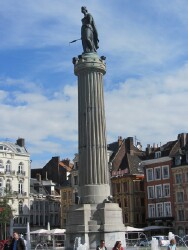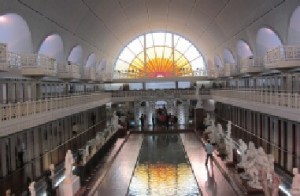Preservationists wisely began to realize a heroic rescue to Lille’s culture and historic center in the 1960s after the devastation caused by two world wars and the closing of several important coal mines and textile mills in the region. Removing the stucco that revealed the colorful Flemish brick and stone facades on many of its buildings was excuse enough for high-end shops and restaurants to move into the center of town, reviving the area around the Grand’Place and what is known today as la vieille ville. The arrival of the high-speed train in 1993 was a boon to the city, connecting Paris to Lille in just an hour. Brussels, the seat of European government, is a mere 35 minutes from Lille by train. Named the European Cultural Capital in 2004, Lille spent some €73 million—the largest sum ever for a single cultural operation in France—and invested another €55 million to reinvent itself. The results are startling.
Useful landmarks for a visit:
– The Place du Théâtre, dominated by the ornate Opera House and the imposing Chamber of Commerce building
– the Rang du Beauregard, a row of lovely brick-and-stone buildings dating from the XVII c.
– the center of the town officially called La Place Gaulle but known more affectionately as la Grand’Place. Marked by a column  supporting a statue of the Déesse du boutefeu in honor of the heroism of the citizens under siege by the Austrians in 1792, the Place is the heartbeat of the city and an important gathering place.
supporting a statue of the Déesse du boutefeu in honor of the heroism of the citizens under siege by the Austrians in 1792, the Place is the heartbeat of the city and an important gathering place.
– The Place Rihour is just behind the Grand’Place and its beautiful formal palace currently harbors the Tourist Office.
– The jewel of museums is the Palais des Beaux-Arts, second in France only to the Louvre in Paris. A rich collection of statues and painting adorn the interior; its recent 6-year renovation shows off its collection brilliantly, set against the colorful walls. There is a stunning exhibit currently running entitled The Tower of Babel.
– A surprising museum in nearby Roubaix, La Piscine is a former municipal art-deco swimming  pool turned art museum, housing a beautifully eclectic collection of sculpture, 20th century art works, ceramics, porcelain and stained glass.
pool turned art museum, housing a beautifully eclectic collection of sculpture, 20th century art works, ceramics, porcelain and stained glass.
– An enormous modern art museum, the LAM, presents a brilliant collection of both 20th and 21st century art, rivaling modern art collections throughout Europe.
– Lille 3000: Every 18 months, Lille hosts an art bonanza like no other. During a 6-month period, shows, exhibits, concerts, dance, food, all all engaged in an enormous theme. This year it is devoted to FANTASY, with events taking place from October 6, 2012 to Jan 13, 2013. If you have a chance to visit Lille during this period, be sure to check out the events: http://www.lilletourism.com/document/fantastic_preprogramme_fr.pdf
– Les marchés: 14 outdoor markets are held weekly in Lille and its metropolis, each different and unique. One of the most popular is the one on Sunday mornings in Wazemmes. City hall has an excellent list of its marches: http://www.mairie-lille.fr/fr/Vie_economique/halles-marches
– Gare St-Sauveur: former freight rail station turned exhibit hall, this trendy local has reinvented itself. Open day and night all year round, it’s a hot spot of energy, exhibits, game rooms and atmosphere. Complete with hotel and lounge.
– The Pâtisserie Meert on rue Esquermoise, is an institution in Lille. Founded in 1761, it is best known for its vanilla-cream-filled gaufre, a very thin, flat waffle, served in a stunning 19th century tea room, replete with chandeliers and wrought-iron balconies. http://www.ina.fr/art-et-culture/gastronomie/video/I07268594/la-patisserie-meert-a-lille.fr.html
Leave a Reply